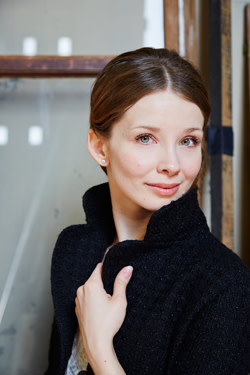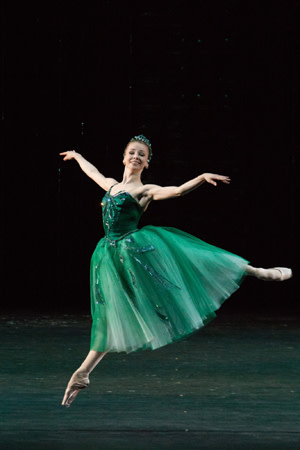Crime and enchantment

Simply sign up to the Life & Arts myFT Digest -- delivered directly to your inbox.
When London was introduced to Evgenia Obraztsova in 2005, she was the Mariinsky Ballet’s youngest-ever Juliet, all youthful radiance and classical purity, drawing comparisons with Soviet legend Galina Ulanova. Eight years later, she has followed in Ulanova’s footsteps in a more unexpected manner: in 2012, she left her alma mater to join the rival Bolshoi Ballet in Moscow as a principal.
Unlike Ulanova, however, who was transferred manu militari by Stalin himself, Obraztsova made the move of her own accord at the invitation of one man: Sergei Filin, a former Bolshoi principal who had recently been appointed artistic director. In January, on the day of Obraztsova’s 29th birthday, Filin was the victim of a vicious acid attack as he was returning home at night, unleashing a hurricane in Russian ballet that shows no signs of dying down.
It’s the middle of the afternoon in Paris, and Obraztsova, who is in town to rehearse La Sylphide ahead of her debut with the Paris Opera Ballet, looks tired. The day before, she went straight from the Palais Garnier to the train station to spend the night in Aachen, Germany, where Filin has been treated since February. She brings back worrying news: the Bolshoi director retains only 10 per cent vision in one eye, and doctors are still unsure whether the other will remain permanently blind, despite extensive surgery and implants.
The medical facts haven’t stopped the bloody war of words in the Russian media from raging on. A Bolshoi soloist, Pavel Dmitrichenko, and two accomplices are currently detained for the crime but a number of Bolshoi artists claim their colleague’s confession was obtained under duress. Last week, star principal Nikolai Tsiskaridze was let go from the theatre after giving currency to a rumour that Filin had faked or exaggerated his injuries. “It’s inhuman and absolutely incorrect to say such a thing,” Obraztsova says wearily. “These people just don’t put themselves in his or his mother’s shoes. I saw his eyes, his skin – it’s a tragedy.” It is a disturbing conversation to have with a ballerina but Obraztsova handles it with unflagging grace.
She has sweetly given up the chair in her Paris dressing-room despite my protests, and is curled up on the coffee table. Even clad in a thick body warmer and sweatpants, she is a luminous presence, with dainty, finely drawn features. For a modern Russian ballerina, she is unusually petite: a natural Aurora rather than a long-limbed swan. This fact had seemed to limit her at the Mariinsky, where, the current wisdom goes, you need to dance Swan Lake to be considered for promotion to principal.
“I think it’s just a fad, and it’s changing already,” Obraztsova says. “It’s mad. [Mariinsky star] Ulyana Lopatkina is very tall, for instance, and for that reason she has never performed Don Quixote or The Sleeping Beauty. Can you imagine anyone telling her: you haven’t done Sleeping Beauty, so you can’t be a prima ballerina?”
When asked if this was the reason she last year left the Mariinsky, however, she shakes her head lightly. Petite or not, until a few years ago, she seemed well on her way to stardom in St Petersburg. A native of the city, born to a family of ballet dancers, she graduated in 2002 from the Vaganova Academy straight into the Mariinsky, “a fairytale world” in her young eyes. Former ballerina Ninel Kurgapkina, one of Agrippina Vaganova’s last pupils, immediately took her under her wing – a crucial alliance in Russian ballet, where personal coaches oversee and promote a select number of pupils.
Under Kurgapkina’s guidance, she soon showed the rarest of gifts on stage. An enchantingly warm performer, she brings genuine charm and sweetness to the Romantic repertoire, from La Sylphide to Giselle. Her technique also caught the eye of two specialists of 19th-century ballet reconstructions, Pierre Lacotte and Sergei Vikharev, who both set works on her in St Petersburg, and international invitations started to land at her door. As Aurora in The Sleeping Beauty, she dazzled the FT’s Clement Crisp, who compared her to “a bird throwing off impossible roulades of notes”.
Treacherous company politics, a recurring theme in today’s Russian ballet world, put the brakes on her career. In 2008, Valery Gergiev appointed Yuri Fateyev, a former dancer and répétiteur, “acting head” of the Mariinsky Ballet, a title he still holds today. Since his arrival, unrest has been brewing in St Petersburg. In 2011, dancer representatives sent an open letter to the Russian minister of culture to complain of poor working conditions and unfair management practices; instead of joining the company, top Vaganova graduates have increasingly chosen to start their careers elsewhere, among them Olga Smirnova, the Bolshoi’s bright young star.
“There was no dialogue at all with him, just a monologue, and I couldn’t evolve,” Obraztsova says. “The Mariinsky needs a very strong leader, someone who has a mind of his own, but Yuri is easily influenced. He has made the company very flat.” By then a first soloist, she stopped getting new roles and, on one instance, was excluded from a ballet already in her repertoire, Balanchine’s Apollo, on the grounds that casting her had been a “grave mistake”. (She would later return to the role at the Bolshoi with the blessing of the Balanchine Trust.)
She met Filin in 2009. “He has played a very special role in my life. Every artist needs a guide, a father-figure, and he’s just that for me.” A few months after he took over at the Bolshoi, he invited Obraztsova to join him – not at her Mariinsky level but, in a very unusual move, straight as a principal.

Now that she has changed sides, so to speak, I ask what she thinks of the rivalry between St Petersburg and Moscow. “The differences between the two cities are exaggerated,” she replies. “The Mariinsky shaped me as a ballerina but the Bolshoi is still the Russian school. The difference is one of temperament – Moscow is more dynamic, St Petersburg calmer.”
Still, as a recently arrived Filin protégée, I venture, the acid attack must have made Moscow a rather hostile environment. Obraztsova sees it as an isolated criminal act, she says, and denies feeling any anxiety at the Bolshoi. Like many company dancers, she has thrown all her energies into work. Less than two weeks after the attack, she made her debut in one of the great classical roles, Nikiya in La Bayadère, which she repeats in London in early August. This month she will be Tatiana in John Cranko’s Onegin, a Bolshoi premiere. She’s used to dividing her career into creative periods, and says the current one is “the best of my life. I can finally explore the experience I’ve already gained freely, in a large repertoire. Filin has monumental plans for the company.”
Obraztsova has also looked to other arts for inspiration amid the turmoil. Acting was one of her first passions (she portrayed a young ballerina in Cédric Klapisch’s 2005 film Russian Dolls), and for the role of Tatiana, she is working with Russian actress Alisa Grebenshchikova, a close friend.
Literature is another inspiration, including religious works (she is a devout Orthodox believer). What does she make, then, of the fact that the sublime seems to mix readily with criminal sins in Russian ballet? She pauses before answering. “The Russian mentality is composed of so many contrasts: something magnificent will stand alongside something terrible. And people remain very spiritual. Russians are often represented as a kind of enigma for foreigners,” she says with a smile. “Maybe that’s the reason.”
——————————————-
La Bayadère, August 2-3, Royal Opera House, London; www.roh.org.uk
Comments